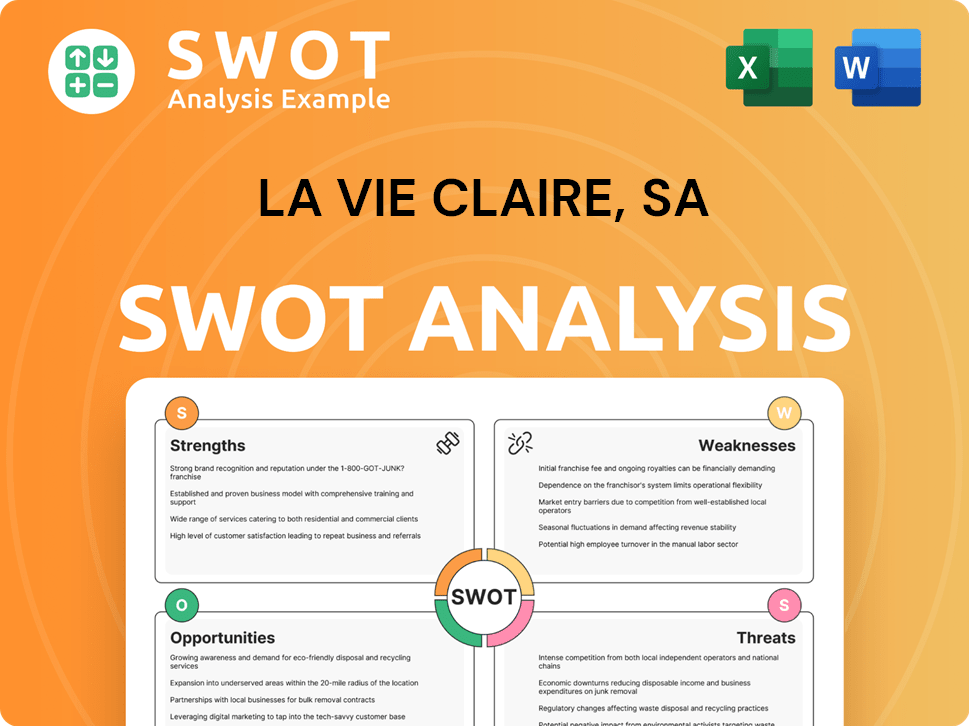La Vie Claire, SA Bundle
How has La Vie Claire, a French company, evolved since its inception?
Journey back to 1946, and discover the fascinating origins of La Vie Claire, a French company that pioneered the organic food movement. From its humble beginnings as a newspaper championing healthy eating, La Vie Claire transformed into a cooperative and eventually a retail powerhouse. This La Vie Claire, SA SWOT Analysis unveils the strategies behind its enduring success.

La Vie Claire's history is a testament to its commitment to organic products, expanding from a simple vision to a network of over 300 stores. The company's growth, including its impressive 8% turnover increase in 2024, reflects its ability to adapt and thrive in the competitive organic market. Understanding the La Vie Claire history offers valuable insights into the evolution of a leading French company and its impact on the industry. This company's journey also includes a famous cycling sponsorship.
What is the La Vie Claire, SA Founding Story?
The founding of the La Vie Claire company is deeply rooted in the personal experiences and vision of its founder, Henri-Charles Geffroy. His journey began after World War I, where he was exposed to mustard gas. This experience led him to embrace a natural diet, which became the foundation for his approach to health and wellness. This transformation sparked the creation of the 'La Vie Claire' magazine in 1946.
The magazine served as a platform to share Geffroy's insights on healthy eating and to connect with individuals seeking a 'clear life' through conscious consumption. The success of the magazine and the demand for the foods he advocated led to a pivotal decision. In 1948, Geffroy established the first La Vie Claire cooperative in Paris, marking the official launch of the company. This cooperative model was designed to provide subscribers with access to 'healthy food,' addressing the limited availability of such products at the time.
The initial business model of La Vie Claire centered around a cooperative structure. This model offered a curated selection of products that met Geffroy's stringent standards for natural and healthy food. The first products likely included organic fruits, vegetables, and seeds, aligning with his dietary principles. The name 'La Vie Claire,' which translates to 'the clear life,' encapsulated Geffroy's core philosophy: 'think clearly, see clearly, act clearly, and live a clear life.' Initial funding came from the cooperative's membership and early sales. This reflected a bootstrapped approach driven by community demand. A primary challenge was building a supply chain for organic products, given the nascent stage of the concept. The cultural context of post-war France, with a growing awareness of health and well-being, played a significant role in the company's creation, as people sought healthier alternatives. Read more about the company's mission, vision, and core values in this article: Mission, Vision & Core Values of La Vie Claire, SA.
La Vie Claire's origins are linked to Henri-Charles Geffroy's personal health journey and his vision for a 'clear life' through healthy eating.
- The 'La Vie Claire' magazine, launched in 1946, paved the way for the company's establishment.
- The first cooperative was founded in Paris in 1948, providing access to organic products.
- The company's initial focus was on organic foods, with funding from cooperative members.
- The post-war era's health consciousness influenced the company's success.
La Vie Claire, SA SWOT Analysis
- Complete SWOT Breakdown
- Fully Customizable
- Editable in Excel & Word
- Professional Formatting
- Investor-Ready Format

What Drove the Early Growth of La Vie Claire, SA?
The early growth and expansion of the La Vie Claire company, a French company, marked a significant evolution from its cooperative beginnings to a well-known retail network. The company transitioned from its initial cooperative in 1948 to 'l'Aliment sain' in 1951, later becoming 'Société française d'alimentation saine' in 1965. This period saw the gradual expansion of its product range to include a wider variety of organic and natural products.
A pivotal moment in La Vie Claire history occurred in 1980 when Bernard Tapie acquired the company. At the time, the company had a turnover of approximately 200 million francs, which is about 30 million Euros, and operated around 250 stores. Tapie's ownership led to network renovations and brand image rejuvenation, including the sponsorship of a cycling team. This period of growth was driven by the increasing interest in organic products.
By 1996, La Vie Claire's turnover had decreased to 10.6 million euros with 120 stores before being sold to Distriborg, a leader in organic food distribution, owned by Régis Pelen. Under Distriborg, La Vie Claire experienced renewed growth, capitalizing on the rising demand for organic products. The company has reportedly doubled its store count over the last decade, demonstrating significant expansion.
In 2018 alone, La Vie Claire added more than 56 new locations, reaching a total of 354 shops. This expansion reflects a strategic focus on expanding its retail footprint and strengthening its private label offerings, which now include over 2,000 products. The company has also established a limited international presence. The market reception during these growth phases has been generally positive, fueled by rising consumer health consciousness and a growing preference for specialized organic stores. To understand more about the company's target audience, read Target Market of La Vie Claire, SA.
The sponsorship of a cycling team during Bernard Tapie's ownership played a crucial role in rejuvenating the La Vie Claire brand image. This strategic move helped increase the visibility of the company. While the exact financial details of the cycling sponsorship are not readily available, it was a significant part of the company's marketing strategy during that period. The cycling team sponsorship was a key element in the company's brand strategy.
La Vie Claire, SA PESTLE Analysis
- Covers All 6 PESTLE Categories
- No Research Needed – Save Hours of Work
- Built by Experts, Trusted by Consultants
- Instant Download, Ready to Use
- 100% Editable, Fully Customizable

What are the key Milestones in La Vie Claire, SA history?
The La Vie Claire company's journey, a significant part of La Vie Claire history, is marked by significant milestones. The company's evolution showcases its adaptability and commitment to the organic market.
| Year | Milestone |
|---|---|
| 1948 | Establishment of the first organic farming store in Paris, marking the company's entry into the organic market. |
| 2006 | Launch of the 'Petits Prix Bio' program, offering affordable organic products. |
| 2016 | Securing the Bioentreprisedurable® label, highlighting the company's commitment to sustainability. |
| 2024 | Reported growth of 8%, attributed to increased sales volume and store traffic. |
| 2025 | Launch of its own brand of dietary supplements, Vita Claire. |
La Vie Claire has consistently focused on innovation, particularly in its product offerings. The company has launched over 350 innovations in the past two years, and now offers a selection of 2,000 references.
The company currently boasts a selection of 2,000 references that prioritize taste, organoleptic qualities, and transparency in origin and composition.
In 2025, La Vie Claire launched its own brand of dietary supplements, Vita Claire, comprising 11 targeted solutions manufactured in France.
The 'Petits Prix Bio' program is expanding in 2025 to nearly 200 references, with 100 products priced under 3 euros and prices blocked for a year.
La Vie Claire is actively optimizing recipes to achieve optimal Nutri-Score and Planet-Score ratings for its products.
Despite its successes, La Vie Claire company has faced challenges, including market fluctuations and economic pressures. The organic market experienced a slowdown in 2023, and inflation impacted consumer spending.
The organic market in France experienced a period of slowdown with modest progression in 2023.
Inflation in 2024 led to a reduction in food spending among French consumers, impacting the share of organic products in shopping baskets, which declined to 5.6% in 2023 from 6% in 2022.
Supermarkets reduced their organic ranges, leading to a decline in sales value in that channel.
La Vie Claire responded by intensifying its focus on making organic food more accessible and preserving consumer purchasing power.
In 1996, the company faced a significant challenge when its turnover dropped to 10.6 million euros, leading to its sale.
La Vie Claire managed to outperform the market during these periods, with a reported growth of 8% in 2024.
For more insights into the competitive landscape, consider exploring the Competitors Landscape of La Vie Claire, SA.
La Vie Claire, SA Business Model Canvas
- Complete 9-Block Business Model Canvas
- Effortlessly Communicate Your Business Strategy
- Investor-Ready BMC Format
- 100% Editable and Customizable
- Clear and Structured Layout

What is the Timeline of Key Events for La Vie Claire, SA?
The history of La Vie Claire, a French company, is marked by significant milestones that have shaped its presence in the organic food market. From its origins as a magazine promoting healthy eating to its expansion as a retail chain, La Vie Claire has evolved significantly over the years. The company's journey includes periods of growth, strategic partnerships, and adaptation to changing market dynamics, reflecting its commitment to providing organic products and promoting a sustainable lifestyle. For a deeper dive into the company's strategic approach, explore the Growth Strategy of La Vie Claire, SA.
| Year | Key Event |
|---|---|
| 1946 | Henri-Charles Geffroy founded 'La Vie Claire' magazine, which promoted healthy eating. |
| 1948 | The first La Vie Claire cooperative store opened in Paris, selling organic products. |
| 1951 | 'l'Aliment sain' was founded, replacing the cooperative structure. |
| 1965 | 'l'Aliment sain' became 'Société française d'alimentation saine.' |
| 1980 | Bernard Tapie acquired the company, which had 250 stores and a turnover of 30 million Euros. |
| 1984 | La Vie Claire sponsored a professional cycling team, gaining significant brand visibility; this sponsorship significantly impacted the cycling world. |
| 1996 | The company was sold to Distriborg after a period of decreased turnover. |
| 2006 | Launch of the 'Petits Prix Bio' program to make organic products more affordable. |
| 2016 | La Vie Claire received the Bioentreprisedurable® label, recognizing its commitment to responsible practices. |
| 2018 | The company significantly expanded its network, opening over 56 new locations and reaching 354 stores. |
| 2023 (October) | Relocation of La Vie Claire's headquarters from Montagny to Grigny, coinciding with the construction of a new 20,000 m² warehouse. |
| 2024 | Achieved a turnover of 332 million euros, representing an 8% growth at constant scope, and opened 7 new stores, bringing the total to 325. The fruit and vegetable segment saw a 10% growth in turnover. |
| 2025 | Plans to open 10 new stores; launches its new private label, Vita Claire, for dietary supplements; aims to become an 'entreprise à mission' (mission-driven company); and expands its 'Petits Prix Bio' program to nearly 200 references. |
La Vie Claire anticipates a 7% growth at a constant scope in 2025. The company plans to further develop and promote its private label products, focusing on optimizing Nutri-Score and Planet-Score ratings for all 2,000 references by the end of 2025. They are also planning 250 new product launches, particularly in food categories like sauces, chocolates, soups, prepared dishes, oils, and beverages.
The company has ambitious network development plans, with 10 new store openings projected for 2025 across metropolitan France and its overseas departments and regions (DROM). La Vie Claire will also reinforce its 'Petits Prix Bio' program to make organic products more accessible. They are working on deploying click & collect services and implementing a new logistics platform.
La Vie Claire aims to become an 'entreprise à mission,' reflecting its commitment to sustainability. The company's leadership anticipates the organic market will continue to develop, with a projected growth of 5% to 7% in 2025 for the overall market. The company's strategic focus remains on quality, accessibility, and environmental responsibility.
The company's future direction is deeply connected to its founding vision, promoting a sustainable lifestyle. Their ongoing commitment to quality, accessibility, and environmental responsibility positions them to capitalize on the increasing consumer demand for organic and eco-friendly products in France and beyond.
La Vie Claire, SA Porter's Five Forces Analysis
- Covers All 5 Competitive Forces in Detail
- Structured for Consultants, Students, and Founders
- 100% Editable in Microsoft Word & Excel
- Instant Digital Download – Use Immediately
- Compatible with Mac & PC – Fully Unlocked

Related Blogs
- What is Competitive Landscape of La Vie Claire, SA Company?
- What is Growth Strategy and Future Prospects of La Vie Claire, SA Company?
- How Does La Vie Claire, SA Company Work?
- What is Sales and Marketing Strategy of La Vie Claire, SA Company?
- What is Brief History of La Vie Claire, SA Company?
- Who Owns La Vie Claire, SA Company?
- What is Customer Demographics and Target Market of La Vie Claire, SA Company?
Disclaimer
All information, articles, and product details provided on this website are for general informational and educational purposes only. We do not claim any ownership over, nor do we intend to infringe upon, any trademarks, copyrights, logos, brand names, or other intellectual property mentioned or depicted on this site. Such intellectual property remains the property of its respective owners, and any references here are made solely for identification or informational purposes, without implying any affiliation, endorsement, or partnership.
We make no representations or warranties, express or implied, regarding the accuracy, completeness, or suitability of any content or products presented. Nothing on this website should be construed as legal, tax, investment, financial, medical, or other professional advice. In addition, no part of this site—including articles or product references—constitutes a solicitation, recommendation, endorsement, advertisement, or offer to buy or sell any securities, franchises, or other financial instruments, particularly in jurisdictions where such activity would be unlawful.
All content is of a general nature and may not address the specific circumstances of any individual or entity. It is not a substitute for professional advice or services. Any actions you take based on the information provided here are strictly at your own risk. You accept full responsibility for any decisions or outcomes arising from your use of this website and agree to release us from any liability in connection with your use of, or reliance upon, the content or products found herein.